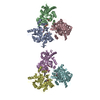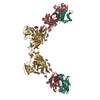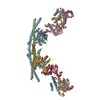+ Open data
Open data
- Basic information
Basic information
| Entry | Database: EMDB / ID: EMD-0347 | |||||||||
|---|---|---|---|---|---|---|---|---|---|---|
| Title | Apo form metabotropic glutamate receptor 5 with Nanobody 43 | |||||||||
 Map data Map data | Apo form metabotropic glutamate receptor 5 with Nanobody 43, primary map | |||||||||
 Sample Sample |
| |||||||||
| Function / homology |  Function and homology information Function and homology informationA2A adenosine receptor binding / regulation of translational elongation / phospholipase C-activating G protein-coupled glutamate receptor signaling pathway / G protein-coupled receptor activity involved in regulation of postsynaptic membrane potential / trans-synaptic signaling by endocannabinoid, modulating synaptic transmission / adenylate cyclase inhibiting G protein-coupled glutamate receptor activity / positive regulation of long-term neuronal synaptic plasticity / : / desensitization of G protein-coupled receptor signaling pathway / G protein-coupled glutamate receptor signaling pathway ...A2A adenosine receptor binding / regulation of translational elongation / phospholipase C-activating G protein-coupled glutamate receptor signaling pathway / G protein-coupled receptor activity involved in regulation of postsynaptic membrane potential / trans-synaptic signaling by endocannabinoid, modulating synaptic transmission / adenylate cyclase inhibiting G protein-coupled glutamate receptor activity / positive regulation of long-term neuronal synaptic plasticity / : / desensitization of G protein-coupled receptor signaling pathway / G protein-coupled glutamate receptor signaling pathway / neurotransmitter receptor activity involved in regulation of postsynaptic cytosolic calcium ion concentration / astrocyte projection / Class C/3 (Metabotropic glutamate/pheromone receptors) / protein kinase C-activating G protein-coupled receptor signaling pathway /  glutamate receptor activity / Neurexins and neuroligins / protein tyrosine kinase activator activity / : / positive regulation of protein tyrosine kinase activity / glutamate receptor activity / Neurexins and neuroligins / protein tyrosine kinase activator activity / : / positive regulation of protein tyrosine kinase activity /  regulation of synaptic transmission, glutamatergic / regulation of synaptic transmission, glutamatergic /  protein tyrosine kinase binding / dendritic shaft / locomotory behavior / protein tyrosine kinase binding / dendritic shaft / locomotory behavior /  learning / G protein-coupled receptor activity / postsynaptic density membrane / synapse organization / learning / G protein-coupled receptor activity / postsynaptic density membrane / synapse organization /  regulation of protein phosphorylation / Schaffer collateral - CA1 synapse / regulation of protein phosphorylation / Schaffer collateral - CA1 synapse /  cognition / cellular response to amyloid-beta / cognition / cellular response to amyloid-beta /  regulation of translation / chemical synaptic transmission / G alpha (q) signalling events / regulation of translation / chemical synaptic transmission / G alpha (q) signalling events /  dendritic spine / positive regulation of MAPK cascade / learning or memory / glutamatergic synapse / regulation of DNA-templated transcription / identical protein binding / dendritic spine / positive regulation of MAPK cascade / learning or memory / glutamatergic synapse / regulation of DNA-templated transcription / identical protein binding /  plasma membrane / plasma membrane /  cytoplasm cytoplasmSimilarity search - Function | |||||||||
| Biological species |   Homo sapiens (human) / Homo sapiens (human) /   Lama glama (llama) Lama glama (llama) | |||||||||
| Method |  single particle reconstruction / single particle reconstruction /  cryo EM / Resolution: 7.9 Å cryo EM / Resolution: 7.9 Å | |||||||||
 Authors Authors | Koehl A / Hu H / Feng D / Zhang Y / Sun B / Kobilka TS / Pardon E / Steyaert J / Mathiesen JM / Skiniotis G / Kobilka BK | |||||||||
 Citation Citation |  Journal: Nature / Year: 2019 Journal: Nature / Year: 2019Title: Structural insights into the activation of metabotropic glutamate receptors. Authors: Antoine Koehl / Hongli Hu / Dan Feng / Bingfa Sun / Yan Zhang / Michael J Robertson / Matthew Chu / Tong Sun Kobilka / Toon Laeremans / Jan Steyaert / Jeffrey Tarrasch / Somnath Dutta / ...Authors: Antoine Koehl / Hongli Hu / Dan Feng / Bingfa Sun / Yan Zhang / Michael J Robertson / Matthew Chu / Tong Sun Kobilka / Toon Laeremans / Jan Steyaert / Jeffrey Tarrasch / Somnath Dutta / Rasmus Fonseca / William I Weis / Jesper M Mathiesen / Georgios Skiniotis / Brian K Kobilka /     Abstract: Metabotropic glutamate receptors are family C G-protein-coupled receptors. They form obligate dimers and possess extracellular ligand-binding Venus flytrap domains, which are linked by cysteine-rich ...Metabotropic glutamate receptors are family C G-protein-coupled receptors. They form obligate dimers and possess extracellular ligand-binding Venus flytrap domains, which are linked by cysteine-rich domains to their 7-transmembrane domains. Spectroscopic studies show that signalling is a dynamic process, in which large-scale conformational changes underlie the transmission of signals from the extracellular Venus flytraps to the G protein-coupling domains-the 7-transmembrane domains-in the membrane. Here, using a combination of X-ray crystallography, cryo-electron microscopy and signalling studies, we present a structural framework for the activation mechanism of metabotropic glutamate receptor subtype 5. Our results show that agonist binding at the Venus flytraps leads to a compaction of the intersubunit dimer interface, thereby bringing the cysteine-rich domains into close proximity. Interactions between the cysteine-rich domains and the second extracellular loops of the receptor enable the rigid-body repositioning of the 7-transmembrane domains, which come into contact with each other to initiate signalling. | |||||||||
| History |
|
- Structure visualization
Structure visualization
| Movie |
 Movie viewer Movie viewer |
|---|---|
| Structure viewer | EM map:  SurfView SurfView Molmil Molmil Jmol/JSmol Jmol/JSmol |
| Supplemental images |
- Downloads & links
Downloads & links
-EMDB archive
| Map data |  emd_0347.map.gz emd_0347.map.gz | 2.6 MB |  EMDB map data format EMDB map data format | |
|---|---|---|---|---|
| Header (meta data) |  emd-0347-v30.xml emd-0347-v30.xml emd-0347.xml emd-0347.xml | 14 KB 14 KB | Display Display |  EMDB header EMDB header |
| Images |  emd_0347.png emd_0347.png | 30.8 KB | ||
| Archive directory |  http://ftp.pdbj.org/pub/emdb/structures/EMD-0347 http://ftp.pdbj.org/pub/emdb/structures/EMD-0347 ftp://ftp.pdbj.org/pub/emdb/structures/EMD-0347 ftp://ftp.pdbj.org/pub/emdb/structures/EMD-0347 | HTTPS FTP |
-Related structure data
| Related structure data |  0345C  0346C 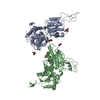 6n4xC 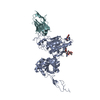 6n4yC 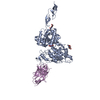 6n50C  6n51C  6n52C C: citing same article ( |
|---|---|
| Similar structure data |
- Links
Links
| EMDB pages |  EMDB (EBI/PDBe) / EMDB (EBI/PDBe) /  EMDataResource EMDataResource |
|---|---|
| Related items in Molecule of the Month |
- Map
Map
| File |  Download / File: emd_0347.map.gz / Format: CCP4 / Size: 6.6 MB / Type: IMAGE STORED AS FLOATING POINT NUMBER (4 BYTES) Download / File: emd_0347.map.gz / Format: CCP4 / Size: 6.6 MB / Type: IMAGE STORED AS FLOATING POINT NUMBER (4 BYTES) | ||||||||||||||||||||||||||||||||||||||||||||||||||||||||||||
|---|---|---|---|---|---|---|---|---|---|---|---|---|---|---|---|---|---|---|---|---|---|---|---|---|---|---|---|---|---|---|---|---|---|---|---|---|---|---|---|---|---|---|---|---|---|---|---|---|---|---|---|---|---|---|---|---|---|---|---|---|---|
| Annotation | Apo form metabotropic glutamate receptor 5 with Nanobody 43, primary map | ||||||||||||||||||||||||||||||||||||||||||||||||||||||||||||
| Voxel size | X=Y=Z: 2.58 Å | ||||||||||||||||||||||||||||||||||||||||||||||||||||||||||||
| Density |
| ||||||||||||||||||||||||||||||||||||||||||||||||||||||||||||
| Symmetry | Space group: 1 | ||||||||||||||||||||||||||||||||||||||||||||||||||||||||||||
| Details | EMDB XML:
CCP4 map header:
| ||||||||||||||||||||||||||||||||||||||||||||||||||||||||||||
-Supplemental data
- Sample components
Sample components
-Entire : Metabotropic Glutamate Receptor 5 - Nb43 Complex
| Entire | Name: Metabotropic Glutamate Receptor 5 - Nb43 Complex |
|---|---|
| Components |
|
-Supramolecule #1: Metabotropic Glutamate Receptor 5 - Nb43 Complex
| Supramolecule | Name: Metabotropic Glutamate Receptor 5 - Nb43 Complex / type: complex / ID: 1 / Parent: 0 / Macromolecule list: all Details: Complex between metabotropic glutamate receptor 5 and Nb43 |
|---|---|
| Source (natural) | Organism:   Homo sapiens (human) Homo sapiens (human) |
| Recombinant expression | Organism:   Spodoptera frugiperda (fall armyworm) / Recombinant strain: SF9 Spodoptera frugiperda (fall armyworm) / Recombinant strain: SF9 |
| Molecular weight | Theoretical: 220 KDa |
-Macromolecule #1: Metabotropic Glutamate Receptor 5
| Macromolecule | Name: Metabotropic Glutamate Receptor 5 / type: protein_or_peptide / ID: 1 Details: Polypeptide encoding metabotropic glutamate receptor 5 Enantiomer: LEVO |
|---|---|
| Source (natural) | Organism:   Homo sapiens (human) Homo sapiens (human) |
| Recombinant expression | Organism:   Spodoptera frugiperda (fall armyworm) Spodoptera frugiperda (fall armyworm) |
| Sequence | String: QSSERRVVAH MPGDIIIGAL FSVHHQPTVD KVHERKCGAV REQYGIQRV EAMLHTLERI NSDPTLLPNI TLGCEIRDSC WHSAVALEQS IEFIRDSLIS S EEEEGLVR CVDGSSSSFR SKKPIVGVIG PGSSSVAIQV QNLLQLFNIP QIAYSATSMD LS DKTLFKY ...String: QSSERRVVAH MPGDIIIGAL FSVHHQPTVD KVHERKCGAV REQYGIQRV EAMLHTLERI NSDPTLLPNI TLGCEIRDSC WHSAVALEQS IEFIRDSLIS S EEEEGLVR CVDGSSSSFR SKKPIVGVIG PGSSSVAIQV QNLLQLFNIP QIAYSATSMD LS DKTLFKY FMRVVPSDAQ QARAMVDIVK RYNWTYVSAV HTEGNYGESG MEAFKDMSAK EGI CIAHSY KIYSNAGEQS FDKLLKKLTS HLPKARVVAC FCEGMTVRGL LMAMRRLGLA GEFL LLGSD GWADRYDVTD GYQREAVGGI TIKLQSPDVK WFDDYYLKLR PETNHRNPWF QEFWQ HRFQ CRLEGFPQEN SKYNKTCNSS LTLKTHHVQD SKMGFVINAI YSMAYGLHNM QMSLCP GYA GLCDAMKPID GRKLLESLMK TNFTGVSGDT ILFDENGDSP GRYEIMNFKE MGKDYFD YI NVGSWDNGEL KMDDDEVWSK KSNIIRSVCS EPCEKGQIKV IRKGEVSCCW TCTPCKEN E YVFDEYTCKA CQLGSWPTDD LTGCDLIPVQ YLRWGDPEPI AAVVFACLGL LATLFVTVV FIIYRDTPVV KSSSRELCYI ILAGICLGYL CTFCLIAKPK QIYCYLQRIG IGLSPAMSYS ALVTKTNRI ARILAGSKKK ICTKKPRFMS ACAQLVIAFI LICIQLGIIV ALFIMEPPDI M HDYPSIRE VYLICNTTNL GVVTPLGYNG LLILSCTFYA FKTRNVPANF NEAKYIAFTM YT TCIIWLA FVPIYFGSNY KIITMCFSVS LSATVALGCM FVPKVYIILA KPERNVRSAF TTS TVVRMH VGDGKSSSAA SRSSSLVNL |
-Macromolecule #2: Nanobody 43
| Macromolecule | Name: Nanobody 43 / type: protein_or_peptide / ID: 2 / Details: Nanobody 43 / Enantiomer: LEVO |
|---|---|
| Source (natural) | Organism:   Lama glama (llama) Lama glama (llama) |
| Recombinant expression | Organism:   Escherichia coli (E. coli) Escherichia coli (E. coli) |
| Sequence | String: QVQLVESGGG LVQAGGSLRL SCAASGRTFT SYAMGWFRQA PGKERESVAA ISSSGGSTHY ADSVKGRFTI SRDNSKNTVY LQMNSLKPED TAVYYCAAAM YGSRWPDWEY DYWGQGTQVT VSSAA |
-Experimental details
-Structure determination
| Method |  cryo EM cryo EM |
|---|---|
 Processing Processing |  single particle reconstruction single particle reconstruction |
| Aggregation state | particle |
- Sample preparation
Sample preparation
| Concentration | 10 mg/mL | |||||||||||||||
|---|---|---|---|---|---|---|---|---|---|---|---|---|---|---|---|---|
| Buffer | pH: 7.5 Component:
| |||||||||||||||
| Grid | Model: Quantifoil R1.2/1.3 / Material: GOLD / Mesh: 200 / Pretreatment - Type: GLOW DISCHARGE | |||||||||||||||
| Vitrification | Cryogen name: ETHANE | |||||||||||||||
| Details | Sample was mono disperse as assayed by gel filtration and SDS PAGE. |
- Electron microscopy
Electron microscopy
| Microscope | FEI TITAN KRIOS |
|---|---|
| Electron beam | Acceleration voltage: 300 kV / Electron source:  FIELD EMISSION GUN FIELD EMISSION GUN |
| Electron optics | C2 aperture diameter: 50.0 µm / Calibrated magnification: 58139 / Illumination mode: FLOOD BEAM / Imaging mode: BRIGHT FIELD Bright-field microscopy / Nominal magnification: 29000 Bright-field microscopy / Nominal magnification: 29000 |
| Image recording | Film or detector model: GATAN K2 SUMMIT (4k x 4k) / Detector mode: COUNTING / Average electron dose: 50.0 e/Å2 |
| Experimental equipment |  Model: Titan Krios / Image courtesy: FEI Company |
- Image processing
Image processing
| Startup model | Type of model: OTHER / Details: The apo structure was used as starting model. |
|---|---|
| Initial angle assignment | Type: RANDOM ASSIGNMENT |
| Final angle assignment | Type: MAXIMUM LIKELIHOOD |
| Final reconstruction | Resolution.type: BY AUTHOR / Resolution: 7.9 Å / Resolution method: FSC 0.143 CUT-OFF / Software - Name: RELION (ver. 2.1) / Number images used: 44831 |
 Movie
Movie Controller
Controller





